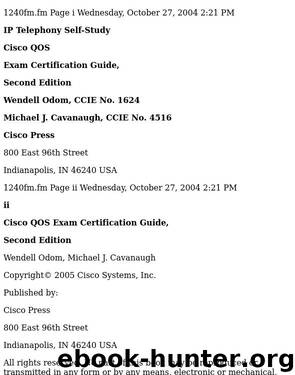Cisco QoS Exam Certification Guide by Wendell Odom

Author:Wendell Odom
Language: eng
Format: epub
QoS ECG.book Page 347 Tuesday, October 19, 2004 1:40 PM
Traffic Policing and Traffic Shaping Concepts 347
Figure 6-5
Mechanics of Traffic Shaping—128-kbps AR, 64-kbps Shaped Rate
Send packets for 62.5 ms per Interval (1/2 the time) in Order to Average 64 kbps
So Bc = 8000 bits (1000 bytes)
Sending Rate
128 kbps
0 kbps
0
125
250
375
500
625
750
875
1000
Time
(Ms)
The router should send literally half of the time to average sending 64 kbps on a 128-kbps link.
Traffic shaping accomplishes this by sending up to half of the time in each Tc.
As shown in the figure, R1 sends at line rate for 62.5 ms, and then is silent for 62.5 ms, completing the first interval. (The Tc defaults to 125 ms for many shaping tools; CB Shaping happens to default to another Tc in this case, but the concept is still valid.) As long as packets are queued and available, R1 repeats the process during each interval. At the end of 1 second, for instance, R1 would have been sending for 62.5 ms in 8 intervals, or 500 ms—which is .5 seconds. By sending for half of the second at 128 kbps, R1 will have sent traffic at an average rate of 64 kbps.
IOS traffic shaping does not actually start a timer for 62.5 ms, and then stop sending when the timer stops. IOS actually calculates, based on the configuration, how many bits could be sent in each interval so that the shaped rate would be met. This value is called the committed burst (Bc) for each interval. It is considered a burst, because the bits actually flow at the physical line rate. The burst is committed, because if you send this much every interval, you are still conforming to the traffic contract. In this example, the Bc value is set to 8000 bits, and the actual process allows the shaper to send packets in each interval until 8000 bits have been sent. At that point, the shaper waits until the Tc has ended, and another interval starts, with another Bc worth of bits sent in the next interval.
With an interval of 125 ms, and 8000 bits per interval, a 64-kbps shaped rate is achieved.
The Bc value is calculated using the following formulas:
Bc = Tc * CIR
or
Bc = Tc * Shaped rate
Download
This site does not store any files on its server. We only index and link to content provided by other sites. Please contact the content providers to delete copyright contents if any and email us, we'll remove relevant links or contents immediately.
Sass and Compass in Action by Wynn Netherland Nathan Weizenbaum Chris Eppstein Brandon Mathis(7969)
Grails in Action by Glen Smith Peter Ledbrook(7942)
Configuring Windows Server Hybrid Advanced Services Exam Ref AZ-801 by Chris Gill(7345)
Azure Containers Explained by Wesley Haakman & Richard Hooper(7333)
Running Windows Containers on AWS by Marcio Morales(6879)
Kotlin in Action by Dmitry Jemerov(5368)
Microsoft 365 Identity and Services Exam Guide MS-100 by Aaron Guilmette(5343)
Microsoft Cybersecurity Architect Exam Ref SC-100 by Dwayne Natwick(5110)
Combating Crime on the Dark Web by Nearchos Nearchou(4917)
The Ruby Workshop by Akshat Paul Peter Philips Dániel Szabó and Cheyne Wallace(4611)
Management Strategies for the Cloud Revolution: How Cloud Computing Is Transforming Business and Why You Can't Afford to Be Left Behind by Charles Babcock(4510)
The Age of Surveillance Capitalism by Shoshana Zuboff(4192)
Python for Security and Networking - Third Edition by José Manuel Ortega(4181)
Learn Wireshark by Lisa Bock(4028)
The Ultimate Docker Container Book by Schenker Gabriel N.;(3837)
Learn Windows PowerShell in a Month of Lunches by Don Jones(3587)
DevSecOps in Practice with VMware Tanzu by Parth Pandit & Robert Hardt(3508)
Windows Ransomware Detection and Protection by Marius Sandbu(3499)
Blockchain Basics by Daniel Drescher(3475)
